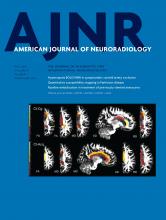We wish to comment on the December 2015 article of Ramalho et al1 entitled “Gadolinium-Based Contrast Agent Accumulation and Toxicity: An Update” in the American Journal of Neuroradiology.
First, the authors introduced the study of Stojanov et al,2 in which gadobutrol (Gadavist; Bayer Schering Pharma, Berlin, Germany) was purported to cause hyperintensity in the dentate nucleus. However, this report lacks evidence because no hyperintensity in the dentate nucleus on T1WI could be noted in their presented figure, despite being seen in all other previous reports.3 In addition, Radbruch et al4 performed a replication study in which gadobutrol showed no correlation with hyperintensity in the dentate nucleus on T1WI. An animal study5 also denied the association between gadobutrol and hyperintensity in the dentate nucleus on T1WI. These results demonstrated that macrocyclic gadolinium-based contrast agents do not cause hyperintensity in the dentate nucleus.
Second, our group6 evaluated gadolinium deposition in the dentate nucleus, internal segment of the globus pallidus, frontal cortical lobe, white matter of the frontal lobe, and cerebral white matter. McDonald et al7 evaluated gadolinium deposition in the dentate nucleus, globus pallidus, thalamus, and pons. In addition, they confirmed the presence of extensive gadolinium deposits prominently clustered within the endothelial wall by using x-ray microanalysis. In the article by Ramalho et al, our work is mistaken for the great work of McDonald et al.
These 2 articles6,7 were published at almost the same time. The submission of our article on November 20, 2014, was earlier than that of McDonald et al,7 submitted on January 5, 2015, but the acceptance was on March 24, 2015—namely, later than the acceptance of the work of McDonald et al on February 12, 2015. Our work and the work of McDonald et al progressed independently, and the work of McDonald et al was published a little earlier than our article.
References
- © 2016 by American Journal of Neuroradiology












